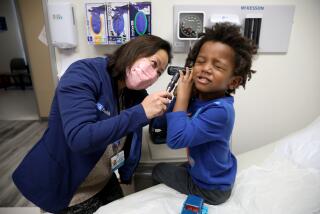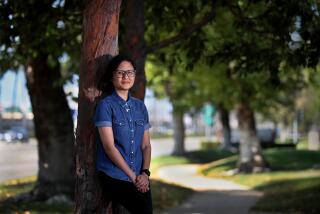Health Care System Is Failing Minorities, Study Says : Research: Report from UCLA School of Public Health and RAND Corp. finds L.A. County does not serve the routine medical needs of blacks and Latinos.
- Share via
The health care system in Los Angeles County fails to serve the needs of blacks and Latinos for medical care outside the hospital, according to a new report from two researchers at the UCLA School of Public Health and the RAND Corp. in Santa Monica.
The detailed statistical analysis of 1987 hospital admission data found that residents of low-income, predominantly minority communities were far more likely to be hospitalized for conditions that usually can be treated in physicians’ offices than the state’s population as a whole or residents of high-income areas of the county. These conditions included high blood pressure, diabetes and respiratory infections.
In addition, poor children living in predominantly black or Latino areas were 15 times more likely to be hospitalized for pneumonia and three to four times more likely to be hospitalized for middle ear infections than children in wealthier parts of the county.
“Many of the county’s poorest black and Latino residents are hospitalized for conditions that should and could have been cared for at an earlier stage,” said the authors of the report. Their study is to be made public later this month.
Higher hospitalization rates for some types of illnesses can indicate that residents in a particular area frequently do not receive care in the early stages of illness, when they are most easily treated.
The lowest hospital admission rates for medical conditions in the county, at least 25% below the state average, were in Malibu, Redondo Beach and West Los Angeles; the highest, 93% above the state average, was in Watts. Other areas with high hospitalization rates included Compton, Inglewood, central and east Los Angeles, north Long Beach and Palmdale.
Dr. David Chernof, president of the Los Angeles County Medical Assn., said the relationship between poverty and the adequacy of medical care is “pretty self-evident.” But he cautioned that the relationship is “complex” and that simplistic conclusions about what the study indicates might be erroneous. Chernof, who has not seen the study, was informed of the findings by a reporter.
For example, pediatricians may be more likely to hospitalize poor children with disadvantaged home situations because of concern about whether they will receive their medicines on a regular basis if they are sent home.
And racial differences in hospitalizations for some conditions may reflect the fact that the conditions occur more frequently in certain groups. Diabetes is more common among Latinos than blacks or whites. High blood pressure occurs about twice as often in blacks as in whites.
Nevertheless, the authors of the report charged: “Los Angeles County has two health care systems within it--one for the poor, largely Latino and black uninsured or under-insured population and another distinct system for the middle- and high-income, privately insured population.”
Robert Valdez, the principal author of the study, termed it “a pictorial representation of the failure of the system.” He said he hopes the study will help county and state health officials focus their attention on the communities where existing public and private medical resources are the most inadequate.
But Valdez acknowledged that the statistics in this “exploratory” study could not explain the precise reasons for the differences.
In addition to health insurance and socioeconomic status, he said that variations in the number and quality of physicians who practice in various areas of the county may play a role.
For instance, fewer pediatricians and internists practice in low-income areas, such as Compton, than in high-income areas, such as Santa Monica.
The researchers used California hospital admission data for 1987 to calculate hospitalization rates for 13 medical conditions, such as high blood pressure, asthma and childhood ear infections, where preventive and primary outpatient care can often prevent hospitalization.
In addition, heart bypass surgery and three other surgeries, where hospitalization rates may be related to health insurance status and income, were studied.
The researchers found that admission rates for medical conditions tended to be well above the expected level in most low-income communities and below the expected levels in most high-income communities. The differences for the four surgeries were “not as dramatic,” with most areas having hospitalization rates that were similar to the state average.
Among other key findings:
* Watts residents were 17 times more likely to be hospitalized for high blood pressure than Malibu residents and almost 10 times more likely to be hospitalized for diabetes.
* Children were admitted to the hospital for pneumonia at an annual rate of 0.1 per 1,000 in La Crescenta, the eighth-richest hospital market area in the county, compared to a rate of 1.52 per 1,000 in Long Beach-Harbor, the poorest hospital market area.
* For bronchitis and asthma, children were 7.6 times more likely to be hospitalized in Palmdale than in Santa Monica.
* There was more than a fourfold variation in hospitalization rates for childhood ear infections between Malibu and Santa Monica, and high admission rate areas, such as eastern Los Angeles and the City of Commerce.
The one-year study was funded by the Tomas Rivera Center in Claremont, a Latino public policy research institute. It was co-authored by Geraldine Dallek, a former RAND fellow who is now executive director of the Medicare Advocacy Project.
More to Read
Sign up for Essential California
The most important California stories and recommendations in your inbox every morning.
You may occasionally receive promotional content from the Los Angeles Times.













